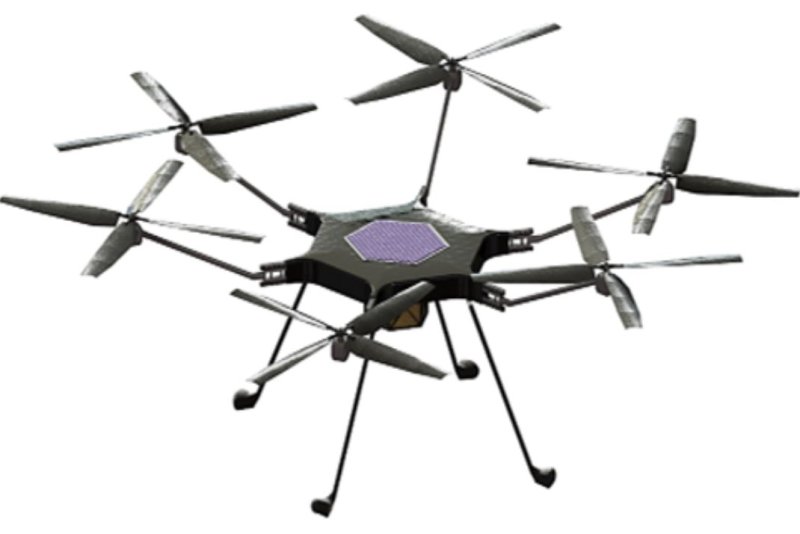1 of 3 | A conceptual image illustrates the six rotors on a possible future Mars helicopter. Image courtesy of NASA
ORLANDO, Fla., July 15 (UPI) -- As the Mars helicopter Ingenuity breaks interplanetary records and captures the public's attention, NASA is quietly researching a bigger, better Mars chopper to navigate the Red Planet's rough terrain.
The next aircraft sent to Mars has no budget, no confirmed design and no launch date, but researchers at NASA and various universities have studied possible destinations for such a mission.
"We're trying to look at building on the success of Ingenuity, and what we could accomplish with a larger, more capable aircraft to Mars in terms of the science we could do and the distances we could go," Teddy Tzanetos, a NASA robotics technologist, said in an interview.
The new Mars aircraft either would be a larger version of Ingenuity, with two rotors, or a much bigger helicopter with six rotors, Tzanetos said. Ingenuity weighs only about 4 pounds; the biggest helicopter being studied would weigh up to 66 pounds.
NASA still is exploring Ingenuity's limits in terms of speed and distance, and engineers like Tzanetos use all new data from the little helicopter to guide research on possible future interplanetary aircraft.
A larger helicopter could carry equipment such as a spectrometer to analyze the composition of rocks. Ingenuity only has optical cameras.
"We could carry a lot more science instruments, although not like a rover could," said Tzanetos, who helped write a research paper on potential missions NASA could tackle with the proposed Mars Science Helicopter.
That is the only name it has so far, to distinguish it from Ingenuity, which was called Mars Helicopter Technology Demonstrator while under development.
The paper lists three possible destinations: Mawrth Vallis, a valley in which NASA has detected evidence of water movement in the past; Milankovič Crater, which could harbor large water ice deposits, and Lucus Planum, a relatively flat area around which some researchers believe a helicopter could help determine when Mars lost its magnetic field and also survey volcanic flows.
NASA's research on a future helicopter includes a possible range of 10 to 15 miles per day; Ingenuity's longest flight so far was about 2,000 feet.
NASA plans to send another mission to Mars in 2026 to collect rock samples drilled by the Perseverance rover. But during press conferences on Ingenuity's success, NASA officials made it clear that mission may be too complicated to add a helicopter.
The next time Mars is close enough to Earth for a rocket launch is December 2022, but NASA typically doesn't build planetary spacecraft quick enough to make that date.
Many people who study Mars exploration say waiting much longer than that would be a shame, said Robert Zubrin, president of the non-profit Mars Society, which advocates for exploration of the Red Planet.
"I think they would be very foolish to stall it that long," said Zubrin, an aerospace engineer and author. "I think a few years from now, people will ask why are you sending something to Mars that can't fly, since we know it's possible now."
Some scientists once scoffed at the idea of Ingenuity, just as they did when NASA sent the small robotic rover Sojourner to Mars in 1997, Zubrin said.
"Even the hard-core scientists had to admit they were wrong about Sojourner being a public relations stunt, and I think we'll see that with Ingenuity also," he said.
The little Sojourner rover was a successful technology demonstration that sent back more than 500 images and operated for 83 Martian days, or sols, even though NASA designed it for only a seven-day mission.
The success of the Sojourner mission led directly to future exploration by four additional robotic rovers, including Perseverance, which is operating on Mars now.
NASA noted recently that Ingenuity is providing valuable scouting tools as engineers plan where to send Perseverance next.
Zubrin said he believes NASA should send an aircraft through the Valles Marineris, the largest canyon in the solar system.
Some scientists also share that idea, said Ray Arvidson, professor of Earth and Planetary Sciences at Washington University in St. Louis. He has been involved in every Mars mission since Viking landed on Mars in 1976.
"The Valles Marineris has a lot of deposits that were probably ancient lakes on the bottom," Arvidson said in an interview. "A helicopter could explore the walls of the canyon vertically and laterally. That would serve science and build public fascination."
NASA has investigated how it might send a standalone aircraft to Mars on a budget-constrained mission that would deploy midair, without the complex landers needed for rovers, for example.
"I think this opens up all sorts of exciting possibilities," Arvidson said. "You'd want to go to exciting places geologically that you couldn't get to with the rovers, which is a lot of terrain."
NASA's Perseverance Mars rover, using its Mastcam-Z camera system, captured this view of the Martian sunset on November 9, 2021, the 257th Martian day, or sol, of the mission. Martian sunsets typically stand out for their distinctive blue color as fine dust in the atmosphere permits blue light to penetrate the atmosphere more efficiently than colors with longer wavelengths. But this sunset looks different: Less dust in the atmosphere resulted in a more muted color than average. The color has been calibrated and white-balanced to remove camera artifacts. Photo courtesy of NASA |
License Photo
















